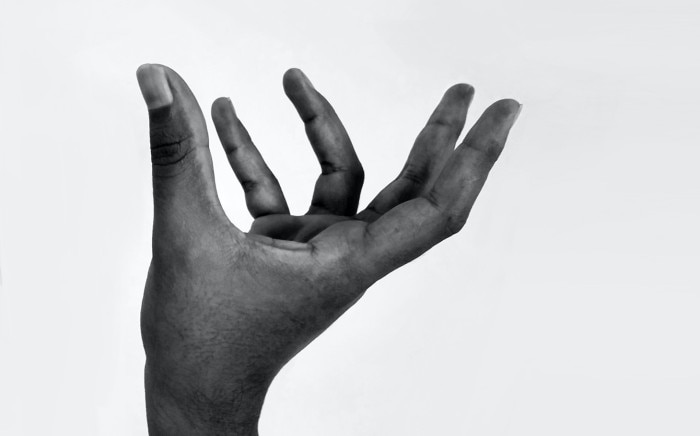MENU
US | USD
US | USD
-
- Benchtop Centrifuges
- Floor-Standing Centrifuges
- Refrigerated Centrifuges
- Microcentrifuges
- Multipurpose Centrifuges
- High-Speed Centrifuges
- Ultracentrifuges
- Concentrator
- High-Speed and Ultracentrifugation Consumables
- Accessories
- Tubes
- Plates
- Device Management Software
- Sample and Information Management
No results found
Search Suggestions

The Hand – A True Marvel
Beyond Science
- Nature
- Off the Bench
- Off the Bench
- Inspiring Science
They are the most versatile tool that evolution has ever produced. They speak the language of signing; they help us think and allow us to create. With our hands, we feel, understand and shape the world.
“It was kind of a crazy idea”, says cellist Burkard Maria Weber. Together with extreme alpine climber Alexander Huber and a number of helpers, he carried a small piano, as well as a cello, across a narrow ridge to the Heidenpfeiler in a forest in southwestern Germany in June of 2019. The professional musician and Mr. Huber, also known as the “Huberbua”, then climbed the 60-meter-high steep face of this sandstone rock – and proceeded to play “Clair de Lune” by Claude Debussy on this plateau measuring a mere ten square meters.
“Concerto Vertical” was the name of this art-in-action, which made it to television. Climbing star Alexander Huber turned out to be an amazingly good pianist, and cellist Burkard Maria Weber was convincing as a surprisingly confident climber. “We wanted to show what hands are capable of”, explains Weber. They allow for both an extremely powerful performance as well as utmost sensitivity. The 54-year-old who, with his lion’s mane and headband, more closely resembles a rock star than a classical soloist, has no problem amalgamating his seemingly contradictory passions. “Climbing even has a positive influence on my performance”, says Weber, “afterwards my joints and fingers are usually completely nimble.”
Delicate and versatile
Our hands are a marvel. 27 bones, connected by joints and tendons, 33 muscles and three major nerve branches, as well as connective tissue, blood vessels and skin endowed with ultrasensitive tactile sensors form the most delicate and versatile gripping and palpitation tool that evolution has ever produced. The palm of the hand is protected by a strong group of tendons that enables a powerful grip. The average grip strength of a man is equivalent to a mass of 50 kilograms. Women, on average, possess only about half as much strength. Athletes are capable of achieving values that may easily surpass 100 kilograms.
At the same time, most people’s fingers are of a slender and graceful build. This is mainly due to the fact that they do not contain any muscle. They are in fact remote-controlled, akin to a marionette on strings. It is through flexible and durable tendons that they are connected to the muscles inside the palm of the hand, the forearm and even the shoulder. These tools allow people to achieve amazing accomplishments. Beginning with lighting a fire, picking up the most delicate seeds of grain from the ground or weaving a net. All the way to the ability to construct delicate clockwork mechanisms, performing surgery on the tiny hearts of newborns or reading Braille.
His musical climbing act was a special test of endurance for Burkard Maria Weber, as well as a reminder of how sensitive and fragile our hands really are. Two years ago, he hadn’t noticed the closing of an automatic car window, which resulted in the tip of his left middle finger being crushed. When he pulled back reflexively, the articular capsule and the tendons were also injured – unfortunately affecting the very finger that is crucial to the orientation on the neck of the cello, and therefore accurate performance. “In the beginning, the pain was hellish, returning periodically after months”, recalls the musician. “Naturally, I was immediately worried that I would never again be able to perform music without pain. For us professional musicians, this is immediately existential.”
Yoga for the sensitive body part
Weber sought help from Dr. Jochen Blum, chief physician at Worms Hospital in Germany. Dr. Blum is an emergency and hand surgeon; he also plays multiple instruments, and as a young man he completed his apprenticeship as a violin maker in Siena. For more than 30 years, he has been offering consultations specifically for musicians. “Particularly with musicians, I only operate if there is absolutely no other way”, he says. Often, as in the case of Burkard Maria Weber, an individually adapted mobility training and targeted relaxation exercises will help – a kind of hand yoga. On rare occasions, Dr. Blum will implant artificial finger joints in musicians or replace a thumb with a toe.
According to Dr. Blum, damage or loss of a thumb is particularly tragic as the thumb is the key feature of the human hand. In particular, the flexible thumb saddle joint plays a pivotal role for this universal tool. It is with its help that we are capable of performing a precise pincer grip as well as power grips. Finally, we are also able to securely hold and artfully move pens and screws thanks to our thumb’s rotating CMJ joint.
Diagnosis via palpation and touch
Hands can be employed as an independent sense. They feel the temperature of water; they guide a key securely into the lock in the dark; their fingertips discover imperfections that are invisible to the naked eye. With a little experience, our fingertips will distinguish real silk from artificial silk and leather from imitation leather. A touch is full of fine nuances; it can sense and pass along, tenderness, warmth and closeness.
A close network of receptors and nerve tracts transmits sensations to our spinal cord and brain. For the hand surgeon, their own hands are the deciding tool. To Jochen Blum, palpation and touch are among his most important diagnostic methods: “They often provide me with more information than x-rays or other technical methods.”
During a follow-up visit in his special office hours for musicians, Jochen Blum closely observes Burkard Maria Weber’s cello playing: bowing; the speed of the left hand; the perfection of the vibrato. He then carefully palpates the musician’s hand. It is slender and sinewy. The blood vessels protrude strongly and wind like vines across the back of the hand. The fingertips display the typical callus-formation of a string musician. Dr. Blum examines the flexibility of the joints; he looks for swelling, sclerosis and unusual structures of those ring tendons which lend stability to the fingers. The doctor is satisfied: “Very good, no more serious abnormalities.” Weber is visibly relieved.
“Concerto Vertical” was the name of this art-in-action, which made it to television. Climbing star Alexander Huber turned out to be an amazingly good pianist, and cellist Burkard Maria Weber was convincing as a surprisingly confident climber. “We wanted to show what hands are capable of”, explains Weber. They allow for both an extremely powerful performance as well as utmost sensitivity. The 54-year-old who, with his lion’s mane and headband, more closely resembles a rock star than a classical soloist, has no problem amalgamating his seemingly contradictory passions. “Climbing even has a positive influence on my performance”, says Weber, “afterwards my joints and fingers are usually completely nimble.”
Delicate and versatile
Our hands are a marvel. 27 bones, connected by joints and tendons, 33 muscles and three major nerve branches, as well as connective tissue, blood vessels and skin endowed with ultrasensitive tactile sensors form the most delicate and versatile gripping and palpitation tool that evolution has ever produced. The palm of the hand is protected by a strong group of tendons that enables a powerful grip. The average grip strength of a man is equivalent to a mass of 50 kilograms. Women, on average, possess only about half as much strength. Athletes are capable of achieving values that may easily surpass 100 kilograms.
At the same time, most people’s fingers are of a slender and graceful build. This is mainly due to the fact that they do not contain any muscle. They are in fact remote-controlled, akin to a marionette on strings. It is through flexible and durable tendons that they are connected to the muscles inside the palm of the hand, the forearm and even the shoulder. These tools allow people to achieve amazing accomplishments. Beginning with lighting a fire, picking up the most delicate seeds of grain from the ground or weaving a net. All the way to the ability to construct delicate clockwork mechanisms, performing surgery on the tiny hearts of newborns or reading Braille.
His musical climbing act was a special test of endurance for Burkard Maria Weber, as well as a reminder of how sensitive and fragile our hands really are. Two years ago, he hadn’t noticed the closing of an automatic car window, which resulted in the tip of his left middle finger being crushed. When he pulled back reflexively, the articular capsule and the tendons were also injured – unfortunately affecting the very finger that is crucial to the orientation on the neck of the cello, and therefore accurate performance. “In the beginning, the pain was hellish, returning periodically after months”, recalls the musician. “Naturally, I was immediately worried that I would never again be able to perform music without pain. For us professional musicians, this is immediately existential.”
Yoga for the sensitive body part
Weber sought help from Dr. Jochen Blum, chief physician at Worms Hospital in Germany. Dr. Blum is an emergency and hand surgeon; he also plays multiple instruments, and as a young man he completed his apprenticeship as a violin maker in Siena. For more than 30 years, he has been offering consultations specifically for musicians. “Particularly with musicians, I only operate if there is absolutely no other way”, he says. Often, as in the case of Burkard Maria Weber, an individually adapted mobility training and targeted relaxation exercises will help – a kind of hand yoga. On rare occasions, Dr. Blum will implant artificial finger joints in musicians or replace a thumb with a toe.
According to Dr. Blum, damage or loss of a thumb is particularly tragic as the thumb is the key feature of the human hand. In particular, the flexible thumb saddle joint plays a pivotal role for this universal tool. It is with its help that we are capable of performing a precise pincer grip as well as power grips. Finally, we are also able to securely hold and artfully move pens and screws thanks to our thumb’s rotating CMJ joint.
Diagnosis via palpation and touch
Hands can be employed as an independent sense. They feel the temperature of water; they guide a key securely into the lock in the dark; their fingertips discover imperfections that are invisible to the naked eye. With a little experience, our fingertips will distinguish real silk from artificial silk and leather from imitation leather. A touch is full of fine nuances; it can sense and pass along, tenderness, warmth and closeness.
A close network of receptors and nerve tracts transmits sensations to our spinal cord and brain. For the hand surgeon, their own hands are the deciding tool. To Jochen Blum, palpation and touch are among his most important diagnostic methods: “They often provide me with more information than x-rays or other technical methods.”
During a follow-up visit in his special office hours for musicians, Jochen Blum closely observes Burkard Maria Weber’s cello playing: bowing; the speed of the left hand; the perfection of the vibrato. He then carefully palpates the musician’s hand. It is slender and sinewy. The blood vessels protrude strongly and wind like vines across the back of the hand. The fingertips display the typical callus-formation of a string musician. Dr. Blum examines the flexibility of the joints; he looks for swelling, sclerosis and unusual structures of those ring tendons which lend stability to the fingers. The doctor is satisfied: “Very good, no more serious abnormalities.” Weber is visibly relieved.
Read more
Read less

